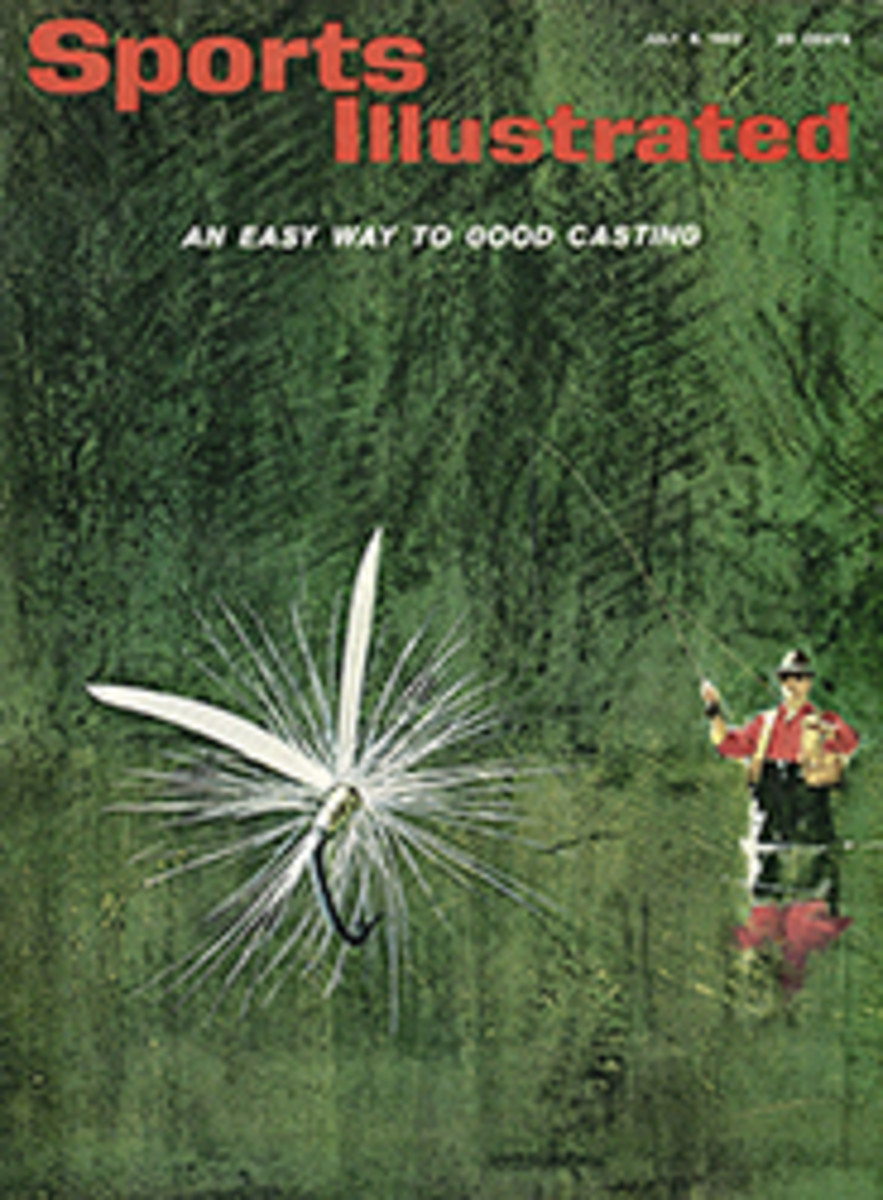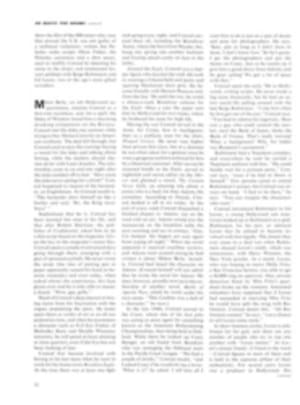
THE WORLD'S MASTER CASTER
It is an odd andinteresting fact that all males in the U.S. have an inborn, God-given talent:they are all expert fishermen. The same men who will rush emotionally to theirgolf pros for lessons, buying a $35 putter every time a putt fails to drop,shun expert guidance when it comes to fishing.
Thesepseudoexperts watching a casting tournament are privately amazed and publiclyscornful at the virtuosity of the casters. Their comments sound something likethis: "Anybody could cast with that expensive equipment." "With allthat practice, I could cast with a broomstick." "I like to fish. Idon't want to waste time just casting." "I know they can cast. But canthey catch fish?"
Such commentshave been heard often by Master Caster Jon Tarantino (see cover), a young manof 26 who lives in San Francisco. Jon Tarantino dissents. "It's just thatfishing is so much easier and more enjoyable when you know how to castright," he says. "You don't have the fly around your ears all the time,and you don't waste precious fishing time standing around cussingyourself."
Jon Tarantino isworth listening to. He has won the world amateur all-around castingchampionship for the last six years—every year the tournament has beenheld.
These six worldchampionships reflect the astonishing talent of a young man who has dominatedthe delicate, difficult, graceful and precise sport almost from the first dayhe picked up a rod.
That was in April1948, when Jon was 10 years old. Only two months later, having passed his 11thbirthday, Jon won the Western States junior dry-fly accuracy title. And thenext month he went on to win the same event in national competition.
"I was veryproud of that," Tarantino says. "From then on I just kept getting moreand more interested. I tried all the games (that's what the tournament eventsare called) and the fellows at the club—the Golden Gate Angling and CastingClub—were more than anxious to help me. That's one of the great things aboutthis sport—the way people try to help you.
"Everybodysays I'm a natural," Jon says, "but I rather argue the point, becauseI've put in an awful lot of hours. I could have taught a monkey in a shortertime than I taught myself.
"Casting iseasy to learn, but to do tournament work, where you want absolute precision foraccuracy and distance—that takes time."
In 1952, when hewas 15, Tarantino entered the national tournament as a senior. "Usually youwait until you are at least 18, but 1 decided I might as well get into thetough competition," he says.
"He was justa fat little kid then," says Doug Merrick of San Francisco, the man whomakes the famed R. L. Winston rods, "but he was already beating everybodyaround the club."
"I'm still afat kid," says Tarantino, "only now I'm taller."
In his firstnational as a senior, youngster Tarantino beat the men, won the skishall-around and came in third in the overall competition.
Skish, acontraction of "skill in fishing," embraces events in which standard,on-the-market fishing gear is used. Specifically, the events are: spinning foraccuracy with a 3/8-ounce lure; bait casting for accuracy with a 5/8-ounceplug; a fly-casting event that combines dry-fly, wet-fly and roll casting; flycasting for distance; bait casting for distance with a 5/8-ounce plug; andspinning for distance.
The next yearTarantino won the national all-around—eight specialized events, some of whichhave little relation to actual fishing. Since then he has won five morenational all-around titles and in last year's competition tied for first.
What makesall-around competition so tough is that it is absolutely necessary for acompetitor to score in all eight events, and in some it is extremely easy tofail if you do not have the feel.
In bait castingfor distance, for example, a 5/8-ounce plug is attached to hair-finemonofilament wound on a small free-running spool in a specially machined reel.If you know what you are doing, you can throw the 5/8-ounce plug more than 400feet. Jon has thrown it 472 feet in practice.
"Five hundredfeet is the four-minute mile for us," Jon says. "That's what we're alltrying for. This game is quite different from real fishing. It might becompared with bench shooting—everyone gets a chance to develop his owntackle."
The trick is tocast without breaking the skinny line. You are allowed five casts and mustcomplete three to score. If you break the line three times you areautomatically out of the all-around.
In worldcompetition the rule is that you must finish with your original tackle, a factthat Jon had driven home to him in an unforgettable manner.
"It was inthe first tournament in Kiel, Germany," he recalls. "I got a backlashand, as we usually do, I just cut it off and started to spool a new line. Thenan official told me that wasn't allowed. I made my last two casts with 26 knotsin the line. There was no other way. I needed those two casts to stay in thetournament."
For all itsdelicacy, tournament casting can generate enormous pressure. "You train allyear and then you've got five minutes to produce or get out," Tarantinosays.' "Sometimes the pressure builds up to such a point that it becomes anordeal to tie a simple knot. You often think you can taste the juice of the bigwatermelon that's stuck in your throat. They say I have no nerves, but I shakemy share."
To win theall-around championship a competitor does not have to win every event, but hemust win or be close to the top in most. This means he cannot afford to lieback and play it safe, staying within average range. He has to go all out—allthe time. Over the years Tarantino has won seven of the 10 world events and 16of the 17 national events. In addition, he holds three world and eight nationalcasting records (below). Of these, the most remarkable are his perfect scoresof 100 points in national and international dry-, wet-, and skish-fly accuracyevents. To get these scores he had to hit his targets on every cast; some ofthese targets were 55 feet away and only 30 inches in diameter. And in theskish-fly events he hit the target 30 times in succession.
"I want to bethe world's best caster and I want to win by casting, not by having anadvantage in equipment," Jon says. "That's the way we all feel. Ofcourse, I want the best equipment I can get. If you know your equipment is thebest you can get the only thing you have to fight is yourself."
The Golden GateAngling and Casting Club helps pay Tarantino's way to the national competition,held by the American Casting Association, which in turn finances the Americanteam on its forays into Europe for the world competition. But Tarantino admitshis pursuit of titles has been expensive. "I was fortunate or unfortunateenough to rise quickly in the game," he says. "When that happens youare afraid of being knocked off, and you spend more hours practicing and morehours experimenting.
"Even when Iwas learning the basics I wanted to know why the opposite things wouldn't work.I was always fiddling with the rods and lines. I know 10 million things thatwon't work and a few that do."
By this constantjiggering Jon has become one of the world authorities on tackle. "The wholething is a matter of balancing your equipment, and it needn't beexpensive," he says. "If you follow what the manufacturer says, you'llprobably be all right."
In spite of allhis records and his encyclopedic knowledge of tackle, the universal questionasked Jon Tarantino is, "Do you fish?"
The answer isyes. He goes fishing every chance he gets. And he gets fish.
His tournamenttravels have given him the opportunity to fish some of the world's famouswaters and, enjoyable as these experiences have been, Jon's favorite groundsare still close to home in California's steelhead and salmon rivers.
Tarantino sums upgood fly casting this way: "There are only a few basics that apply. Thereis very little wrist action. The lift is done with the arm and the wrist. Thereis just the slightest pickup with the wrist as you give the line speed to getit up and behind you. When you come forward there is just the slightest wristaction in the other direction. Proper casting is a matter of comfort, not amatter of rules. The grip should not be too tight on the rod, just comfortablyfirm. The rod is just a continuation of your arm.
"Bring backyour rod with an upward, circular motion of your forearm. I don't like to teachby the clock method—just bring the rod back far enough to get a good, high backcast. Wait until the final moment of turnover, when the line is perfectlystraight behind you, and then bring your arm forward. The important thing is towait until the back cast has turned over completely and the line is straightbehind you, nearly perpendicular to the rod tip.
"If you turnit over too quickly the line speed increases and the fly pops off. If you waittoo long, the fly touches the rocks or trees behind you. Until you learn theproper timing by feel, the simple thing to do is to turn your head and lookover your shoulder to make sure the line is straight before bringing the rodforward. If you make a proper back cast, it is almost impossible not to make aproper forward cast.
"The effortused in correct casting is about one-quarter the effort the average fishermanuses. Good casting takes no sweat and requires so little effort you can easilycast an eight-hour day without knocking yourself out. You have more fun and youcatch more fish."
Proper casting isa matter of comfort." Tarantino's grip on the rod is firm but not tootight. The rod should be thought of as an extension of the arm and the line anextension of the rod and arm. For distance fly casting, Tarantino uses thedouble-line haul (following pages). He also fills his reel with a speciallydesigned ' 'shooting head" line, consisting of 30 feet of a double-taperfly line, 100 feet of 20-pound-test monofilament and a backing of braidedDacron.
Tarantinodemonstrates the double-line haul (above). On the back cast, he pulls downquickly but smoothly on the line until his left arm is extended at his side Asthe fly nears the end of the back cast and the line straightens, Jon raises thehand still holding the line until it meets his right hand at the reel. When therod is started forward, Tarantino again pulls the line down—and back—until hishand is perpendicular to the water. The rod comes forward, Tarantino releasesthe line and it shoots through the guides. In deep water (right), Tarantinooften holds loops loosely in his mouth to keep the line from fouling. To shootit, he opens his mouth on the forward cast.
The common methodof holding monofilament line when casting with an open-face spinning reel is tohook it over the index finger (right). Tarantino objects to this, because theline is often released with a jerk, making it difficult to tell if the lure isin the proper trajectory. Also, when using live bait, the jerk may snap it offthe line. Tarantino instead holds the line against the reel spool with hisforefinger (below, right). When his finger is lifted the line is releasedsmoothly, without any snap.
In surf casting,Tarantino uses a threequarter sidearm motion. With the sinker on the beach, hestarts by bringing the rod forward, pushing with his right hand, pulling withhis left and transferring weight from right to left loot for full power. At thevery end (not shown), his left hand is hard against his chest.
[This articlecontains a table. Please see hardcopy of magazine or PDF.]
NINE ILLUSTRATIONS
FRANCIS GOLDEN

